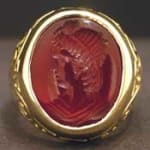Intaglio Depicting a Bust of a Roman Emperor, 1700 CE - 1800 CE
Carnelian-Gold
FJ.6491
Further images
The art of glyptics, or carving on colored precious stones, is probably one of the oldest known to humanity. Intaglios, gems with an incised design, were made as early as...
The art of glyptics, or carving on colored precious stones, is probably one of the oldest known to humanity. Intaglios, gems with an incised design, were made as early as the fourth and third millennia BC in Mesopotamia and Aegean Islands. They display a virtuosity of execution that suggests an old and stable tradition rooted in the earliest centuries. The tools required for carving gems were simple: a wheel with a belt-drive and a set of drills. Abrasives were necessary since the minerals used were too hard for a metal edge. A special difficulty of engraving intaglios, aside from their miniature size, was that the master had to work with a mirror image in mind.
Engravers of the eighteenth century made detailed studies of ancient coins and statuary in order to emulate, and even excel artists of the past. The portrait on this very handsome intaglio resembles the emperor Constantius II (A.D.337-361), third son of emperor Constantine I (the Great). What appears as a type of cap is probably the emperor's hair pulled tight by a diadem, with curls dangling over the forehead. The lovely ornate designs on the ring beautifully compliment the delicate curves of the engraving, bringing together two traditions of artistry suitable for royalty.
Engravers of the eighteenth century made detailed studies of ancient coins and statuary in order to emulate, and even excel artists of the past. The portrait on this very handsome intaglio resembles the emperor Constantius II (A.D.337-361), third son of emperor Constantine I (the Great). What appears as a type of cap is probably the emperor's hair pulled tight by a diadem, with curls dangling over the forehead. The lovely ornate designs on the ring beautifully compliment the delicate curves of the engraving, bringing together two traditions of artistry suitable for royalty.





